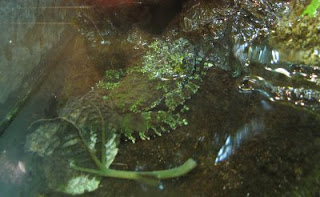In a surprising turn of events I ran into some moss at the aquarium! Mainly it was used in the exhibits of the tropical species to soften the surroundings, keep things moist, and add some greenery. The photo below was the mossiest one of them all!

And what animal just happens to live in the display full of moss? Oh, the mossy frog Theloderma corticale. Many organisms have common names that describe the other plants or animals that they look like. There are the fern mosses (Thuidium sp.) and the feather mosses (Hypnum sp.), just to name a few.
I would have to agree that this frog is well camoflauged to sit on mossy tree trunks and hide from predators. It is an example of an organism evolving to blend in with its surroundings. Those frogs who did not blend in would have been eaten by predators and those that blended in would have been survived to reproduce more mossy looking frogs. This system of natural selection over many years has led to the highly patterned and frilly frog that we see today. (Check out the bottom photo to get a sense of how frilly the arms and legs of the frog were. That was my favorite part about him/her!)

Here is a close up shot of the little guy/gal. I had a hard time shooting through the glass front of the exhibit , so I apologize for the fuziness. You can see some additional photos on the wiki page of this frog species.

















So glad you came to the Aquarium! Your post is really interesting, and it opens up my eyes to the details of that exhibit!
ReplyDeleteI work at the Aquarium and it was excellent to come across your blog.
Thanks! I am glad that you enjoyed the post.
ReplyDeleteI thought that the New England Aquarium was really great and I am looking forward to visiting again soon.